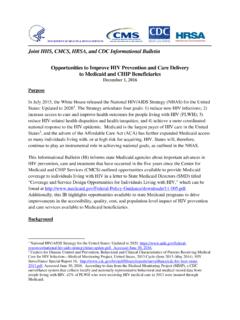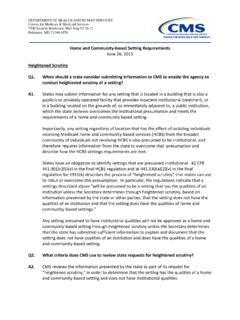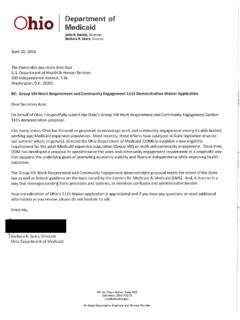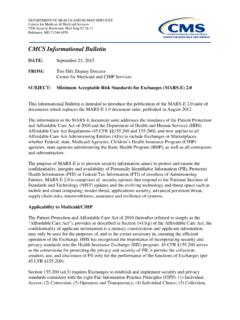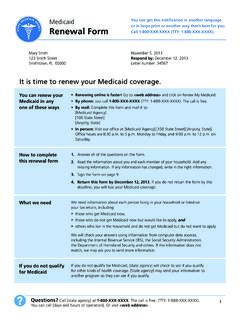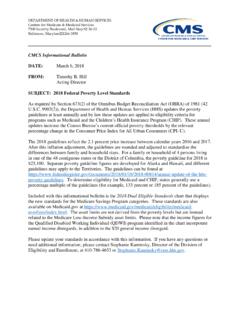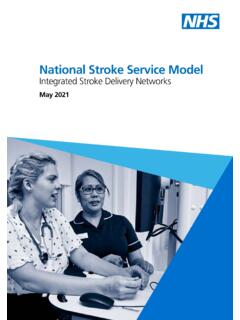Transcription of The Collaborative Care Model: An Approach for Integrating …
1 HEALTH HOME Information Resource Center BRIEF- MAY 2013 This briefwas developed for the Centers for Medicare & Medicaid Services by the Center for Health Care Strategies and Mathematica Policy Research. For more information or technical assistance in developing health homes, The Collaborative Care Model: An Approach for Integrating Physical and Mental Health Care in Medicaid Health Homes Executive Summary Depression and other common mental disorders are common, disabling, and associated with high health care costs and substantial losses in productivity,yet only about 25 percent of patients with these disorders receive effective care. Only 20 percent of adult patients with mental health disorders are seen by mental health specialists and many prefer and receive treatment in primary care settings. Individuals with serious and persistent mental illnessesare more likely to be seen by specialty mental health providers, but they have limited access to effective medical care and high mortality rates,underscoring the need for better connections across primary care and mental health.
2 The Collaborative care model is an evidence-based Approach for integratingphysical and behavioral health services that can be implemented within a primary care-based Medicaid health home model, among other settings. Collaborative care includes: (1) care coordination and care management; (2) regular/proactive monitoring and treatment to target using validated clinical rating scales; and (3) regular, systematic psychiatric caseload reviews s d health itated, case-rate payments, or pay-for-performance mechanisms may provide ubstantially improve medical and mental health outcomes and functioning, as well as reduce health care consultation for patients who do not show clinical improvement. More than 70 randomized controlled trials have shown Collaborative care for common mental disorders such adepression to be more effective and cost-effective than usual care, across diverse practice settings and patient populations.
3 Collaborative care programs have been implemented by large health care organizations anplans in both commercially insured and low income/safety-net fee-for-service reimbursement programs have been a barrier to widespread implementation of Collaborative care, but new reimbursement models using capopportunities to expand its use. Implementation of evidence-based Collaborative care in Medicaid and in integrated care programs for individuals dually eligible for Medicare and Medicaid could s By J rgen Un tzer, MD, MPH, University of Washington; Henry Harbin, MD,Health Care Consultant and former CEO of Magellan Health Services; Michael Schoenbaum, PhD, National Institute of Mental Health; and Benjamin Druss, MD, MPH, Emory University IN BRIEF The integration of physical and mental health care is an important aspect of the Medicaid health home model. Collaborative care programs are one Approach to integration in which primary care providers, care managers, and psychiatric consultants work together to provide care and monitor patients progress.
4 These programs have been shown to be both clinically-effective and cost-effective for a variety of mental health conditions, in a variety of settings, using several different payment mechanisms. This brief highlights the Collaborative care model as one Approach to implementing integrated care under the Medicaid health homes authority. tates are continuously looking for evidence-based approaches to improving the health care of high-need, high-cost Medicaid populations. Strategies to improve the integration of physical and behavioral health care are essential for such individuals with complex needs. Not only are effective integrated approaches needed, but also innovative payment models to cover the costs of care. Health homes are one mechanism that can be used both to integrate primary and mental health care and to pay for the essential components of enhanced care management and care coordination required for effective integration.
5 Authorized by the Affordable Care Act of 2010 (ACA) section 2703, the Medicaid Health Home State Plan Option provides a mechanism to coordinate the primary, acute, behavioral, and long-term and social service needs of targeted beneficiaries. States can link Medicaid beneficiaries who have at least two chronic conditions, have one chronic condition and are at risk for another, or have a serious mental illness to ahealth home to coordinate that person's health care. Regardless of the conditions targeted by the health home, the associated providers must meet all federal and state qualifications to serve as health homes, and must deliver a defined set of services (as further delineated in the section Payment Models for Collaborative Care). Across these services, a key desired outcome of the health home model is improved integration of primary and behavioral health care delivery .
6 This brief highlights the Collaborative care model as one Approach to implementing integrated care under the health homes authority. Future briefs from the Health Home Information Resource Center will highlight other evidence-based or otherwise promising models worthy of consideration for promoting integrated care. Although the model is flexible enough to support a variety of chronic conditions, the Collaborative care model is more often utilized in a primary care-based Approach than within the specialty mental health care delivery system. Behavioral Health Services in Primary Care Behavioral health problems such as depression, anxiety, alcohol or substance abuse are among the most common and disabling health conditions worldwide. They often co-occur with chronic medical diseases and can substantially worsen associated health of depression have been estimated to be 20 percent in Medicaid populationsand 23 percent in the population eligible for both Medicare and When behavioral health problems are not effectively treated, they can impair self-care and adherence to medical and mental health treatments and they are associated with poor health outcomes and increased mortality.
7 They are also associated with decreased work productivity3 , 4 and substantial increases in overall health care costs. For example, Medicaid patients with major depression in addition to a chronic medical condition such as diabetes have more than twice the overall health care costs than those without enrollees with comorbid mental conditions receive worse quality of care for medical conditions suchas diabetes,6and have mortality rates nearly four times as high as those of the general Only 20 percent of adults with common mental disorders receive care from a mental health specialist in any given year8 and primary care practices have long been recognized as the de facto location of care for most adults in the United States with common mental disorders such , 10 Many patients prefer an integrated Approach in which primary care and mental health Health care costs for Medicaid beneficiaries with major depression and a chronic medical condition are twice as high as those for beneficiaries without depression.
8 S The Collaborative Care Model: An Approach for Integrating Physical and Mental Health Care in Medicaid Health Homes 2 providers work together to address medical and behavioral health needs. Older adults in particular prefer treatment of mental disorders in primary care and when they are referred to mental health specialists, no more than half complete such a care providers are well aware of the substantial challenges related to treating patients with mental health problems in primary care and they report serious limitations in the support available from mental health medical homes (PCMH) have been advocated as ways to provide better health care to populations of patients at a lower cost, and effective medical homes should be able to address common mental disorders such as depression. Quality of Care for Common Mental Disorders Effective pharmacological and non-pharmacological treatments exist for common mental health problems, including for depression and anxiety disorders.
9 At the same time, based on 2001-2003 data, only around 40 percent of Americans with a diagnosable mental illness received any specific mental health treatment in the prior year, and only around one-third of those therefore, approximately one in seven overall received treatment that could be characterized as minimally adequate based on practice , 14 Over million Medicaid beneficiaries across the United States receive prescriptions for antidepressants, representing percent of the entire Medicaid population. Of these, nearly 308,000 are individuals eligible for both Medicare and Medicaid (known as Medicare-Medicaid enrollees or dual eligibles).15 Data on Medicare-Medicaid enrollees in Washington State suggest that 44 percent of those younger than 65 years and 27 percent of older Medicare-Medicaid enrollees receive prescriptions for antidepressant medications in any given But many of these patients do not receive these medications in sufficient doses or for a sufficient duration; while others continue to use medications even if they are not effective for them, rather than having their treatment adjusted, due to lack of regular monitoring and clinical inertia.
10 As a result, as few as 20 percent of patients started on antidepressant medications in usual primary care show substantial clinical , 18 Many patients referred to psychotherapy receive an insufficient number of visits and/or ineffective forms of psychotherapy, so that treatment response for this type of treatment is also as low as 20 percent under usual , poor quality of medical care in patients with mental illness may explain a significant portion of their excess Efforts to Improve Care for Mental Disorders in Primary Care Efforts to improve the treatment of common mental disorders in primary care initially focused on screening for common mental disorders, education of primary care providers, development of treatment guidelines, and referral to mental health specialty care. These approaches alone and in combination have not been found to improve patient outcomes, although they may be necessary components of effective people with serious mental disorders treated in public mental health settings, early initiatives similarly sought to improve rates of screening for common medical problems such as diabetes, high cholesterol, and elevated blood pressure; however, many providers that screened for these conditions did not have the capacity to follow up with treatment for patients who screened Another Approach to improve care for patients with behavioral health As few as 20 percent of patients started on antidepressant medications in usual primary care show substantial clinical improvements.
